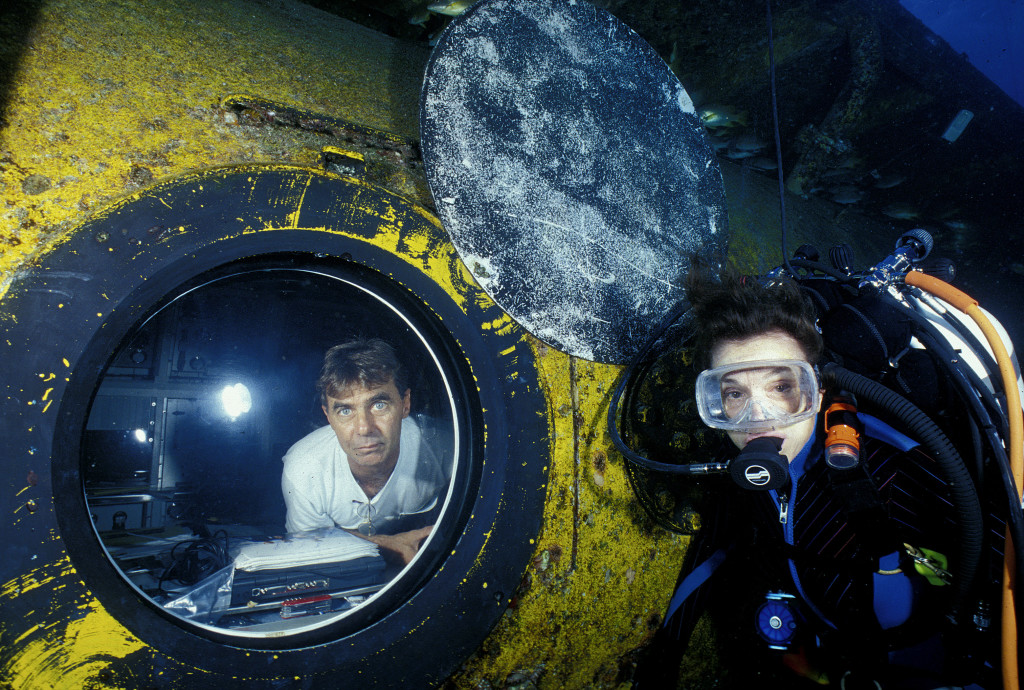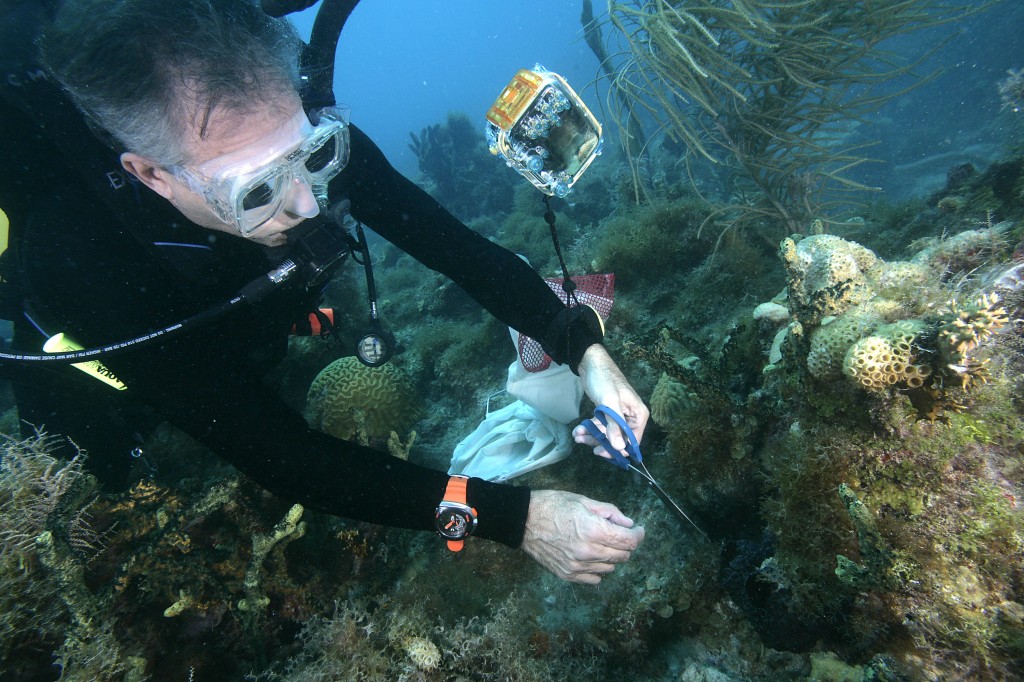Marine Life & Conservation
Divers are Thankful for the National Ocean Policy

As we near the end of 2013, many of us turn our attention to the start of the holiday season, the things are we are thankful for, and our family and friends. Last month, divers in the US showed Congress that they are thankful for the National Ocean Policy.
In fact, seventy four members of our nation’s vibrant dive community, including such members as her “Deepness” Dr. Sylvia Earle, explorer Philippe Cousteau, Jr. and renowned underwater photographer Brian Skerry, supported the National Ocean Policy and a National Endowment for the Oceans to the members of Congress who have an opportunity to show that they too care about our nation’s oceans, coasts and the economies that rely on them.
These are the members of the Water Resources Development Act (WRDA) Conference Committee, who are working to reconcile the versions of WRDA passed by the House and Senate. They will soon consider two provisions critically important to ensuring the long-term health of the nation’s oceans, coasts and Great Lakes. First is the damaging Flores rider, meant to undermine and impede the National Ocean Policy’s implementation by prohibiting the U.S. Army Corps of Engineers (Corps), a key coastal and ocean management agency, from coordinating with coastal states, other federal agencies, and the public as they engage in ocean planning and ecosystem-based management. We know that the National Ocean Policy improves our planning so that we protect important habitat and ocean wildlife, plan to address changing ocean ecosystems, build climate resilience and encourage sustainable use, and provide greater certainty for businesses and other ocean users, including divers. Imposing such an arbitrary restriction harms states, the Corps, and the ocean and coastal economy.
Second is the Senate’s National Endowment for the Oceans (NEO, Title XII to S. 601), a bi-partisan effort to ensure that present and future generations benefit from the ecological, economic, cultural and recreational resources of our ocean, coasts, and Great Lakes through grants to states, tribes and others. NEO would support efforts to conserve and restore ocean resources and help develop the baseline science, monitoring, and observation data to facilitate long term healthy oceans. To ensure our nation has healthy oceans in the future, the letter urges the conferees to OPPOSE and STRIP out the Flores rider and EMBRACE and SUPPORT the provision establishing NEO.
While the dive community is certainly a diverse one, each member has one thing in common: they all benefit from healthy, productive oceans. Divers see firsthand the incredible beauty and, too often, the increasing burden our oceans face. That is why members from the dive community stood up last month to say, hey Congress, the dive community is full of people committed to ensuring our industry, sport and the nation have an ocean ethic. We want you to know that we give thanks that our Nation has an Ocean Policy … and so should you.
Find the letter here.
Source: www.healthyoceanscoalition.org
Top Photo credit: Wolcott Henry/Marine Photobank
Bottom Photo Credit: Greenpeace
Thanks to our friend John Hocevar from Greenpeace who passed this article on to us.
Blogs
Invitation from The Ocean Cleanup for San Francisco port call

6 years ago, The Ocean Cleanup set sail for the Great Pacific Garbage Patch with one goal: to develop the technology to be able to relegate the patch to the history books. On 6 September 2024, The Ocean Cleanup fleet returns to San Francisco bringing with it System 03 to announce the next phase of the cleanup of the Great Pacific Garbage Patch and to offer you a chance to view our cleanup system up-close and personal.
We look forward to seeing you there.
To confirm your presence, please RSVP to press@theoceancleanup.com
PROGRAM
Join The Ocean Cleanup as our two iconic ships and the extraction System 03 return to San Francisco, 6 years and over 100 extractions after we set sail, to create and validate the technology needed to rid the oceans of plastic.
Our founder and CEO, Boyan Slat, will announce the next steps for the cleanup of the Great Pacific Garbage Patch. Giving you a chance to view our cleanup system and the plastic extracted.
Hear important news on what’s next in the mission of The Ocean Cleanup as it seeks to make its mission of ridding the world’s oceans of plastic an achievable and realistic goal.
Interviews and vessel tours are available on request.
PRACTICALITIES
Date: September 6, 2024
Press conference: 12 pm (noon)
Location: The Exploratorium (Google Maps)
Pier 15 (Embarcadero at Green Street), San Francisco, CA
Parking: Visit The Exploratorium’s website for details.
RSVP: press@theoceancleanup.com
Video & photo material from several viewing spots around the bay
We look forward to seeing you there!
ABOUT THE OCEAN CLEANUP
The Ocean Cleanup is an international non-profit that develops and scales technologies to rid the world’s oceans of plastic. They aim to achieve this goal through a dual strategy: intercepting in rivers to stop the flow and cleaning up what has already accumulated in the ocean. For the latter, The Ocean Cleanup develops and deploys large-scale systems to efficiently concentrate the plastic for periodic removal. This plastic is tracked and traced to certify claims of origin when recycling it into new products. To curb the tide via rivers, The Ocean Cleanup has developed Interceptor™ Solutions to halt and extract riverine plastic before it reaches the ocean. As of June 2024, the non-profit has collected over 12 million kilograms (26.4 million pounds) of plastic from aquatic ecosystems around the world. Founded in 2013 by Boyan Slat, The Ocean Cleanup now employs a broadly multi-disciplined team of approximately 140. The foundation is headquartered in Rotterdam, the Netherlands, and opened its first regional office in Kuala Lumpur, Malaysia, in 2023.
Find out more about The Ocean Cleanup at www.theoceancleanup.com.
Marine Life & Conservation
SHARK MONTH ARRIVES AT ROYAL WILLIAM YARD, PLYMOUTH

A shark has been spotted approaching Royal William Yard in Plymouth, much to the surprise of swimmers, paddleboarders and onlookers.
With its distinctive dorsal fin cutting through the water, the sizeable shark swam along the coastline, before turning to head inland towards Firestone Arch at Royal William Yard. The appearance drew a crowd, who were captivated for more than an hour by the unusual sight – and it was all caught on video.
The shark is one of many expected sightings at Royal William Yard over the coming weeks… because today marks the start of Shark Month!
In reality, the ‘shark’ spotted along the Plymouth shoreline was actually a custom-made model, created by the team at Royal William Yard and sailed underwater by Caroline Robertson‑Brown from the Shark Trust, who donned scuba diving gear for the occasion.
The stunt took place to launch Shark Month in style and draw attention to the work of the leading international conservation charity, which is based in Britain’s Ocean City. Spectators were reassured that the water was safe and many entered into the spirit of the performance, swimming or sailing alongside the shark.
Shark Month will take place across Royal William Yard throughout July and will feature an extravaganza of art, entertainment and advocacy for everyone to enjoy. The packed programme of events starts with an art exhibition and ends with a trip on paddleboards with shark experts – with everything from a shark quiz to a Jaws screening in between.
Paul Cox, CEO of the Shark Trust, said: “There are often assumptions and misconceptions when it comes to sharks. This was certainly the case with the shark spotted at Royal William Yard! While the British coastline is home to many species of shark, this was not one of them. However, we’re thrilled it caught people’s attention, because seeing a shark is a special and memorable moment. That is precisely why we want to celebrate these incredible creatures, highlight the need for conservation, and ask for help to safeguard their future.”
For more information about Shark Month at Royal William Yard, visit the Shark Trust Website.
Images and video: Jay Stone
-

 Blogs2 months ago
Blogs2 months agoDiving With… Nico, Ocean Earth Travels, Indonesia
-

 News1 month ago
News1 month agoMurex Bangka Announce New Oceanfront Cottages & Beachfront Dining
-

 Blogs2 months ago
Blogs2 months agoA new idea in freediving from RAID
-

 Marine Life & Conservation1 month ago
Marine Life & Conservation1 month agoIceland issue millionaire whale hunter a licence to murder 128 vulnerable fin whales
-

 Marine Life & Conservation2 months ago
Marine Life & Conservation2 months agoThe Shark Trust Great Shark Snapshot is back
-

 News3 months ago
News3 months agoCharting New Waters; NovoScuba Goes Global with the Launch of their Revolutionary Dive Training Agency!
-

 Gear News1 month ago
Gear News1 month agoNew Suunto Ocean – a dive computer and GPS sports watch in one for adventures below and above the surface
-

 Marine Life & Conservation Blogs2 months ago
Marine Life & Conservation Blogs2 months agoBook Review: Plankton

















